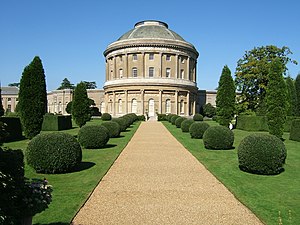User:Giano/Ickworth House


Ickworth House is a country house near Bury St. Edmunds, Suffolk, England. It is a neoclassical building set in parkland. One of England's more unusual houses, it has been unflatteringly described as resembling "a huge bulk, newly arrived from another planet" and as "an overgrown folly"[1] Yet, is now being architecturall re-asessed and recognised as the only building in England comparable with the monumental works of Broullee and Ledoux. [2]
The house, built between 1795 and 1829, was formerly the chief dwelling of an estate owned by the Hervey family, later Marquesses of Bristol, since 1467. The building was the creation of Frederick 4th Earl of Bristol and Bishop of Derry who commissioned the Italian architect Asprucci to design him a classical villa in the sussex countryside. The Earl died in 1803, leaving the completion of house to his successor.
In 1956, the house, park, and a large endowment were given to the National Trust in lieu of death duties. As part of the handover agreement, a 99-year lease on the 60-room East Wing was given to the Marquess of Bristol. However, in 1998 the 7th Marquess of Bristol sold the remaining lease on the East Wing to the National Trust. This wing is now a 27-bedroom hotel.
Architecture
[edit]
The house was based on the designs of Mario Asprucci, an Italian architect; the architects who adapted the design and oversaw construction were Francis Sandys and his brother Joseph Sandys.
The facades are of brick covered in stucco; beneath a roof of slate and lead. The central rotunda 105 ft. high with domed and balustraded roof. the buildomg is entered through central entrance ionic pedimented portico.
The rotunda is decorated with pilasters, which on the lower floor are Ionic and Corinthean above. The ground and first floor and the third floor and the balustraded parapet are divided friezes bas-relief.
The rotunda is flanked by segmental singl story narow wings, which link in the palladian fashion to two terminating pavilions. the segmenatal winds are broken at their centre by projecting bays which house the smoking and pompeian room, both later 19th century additions.
However, unlike the true classical Palladian the terminating pavilions are in fact large wings, complementary to the rotunda which is their corps de logis rather than secondary.
Contents
[edit]Paintings by Velázquez, Titian, Poussin, and Claude Lorraine, as well as an unrivalled series of 18th-century family portraits by artists such as Gainsborough, Reynolds, Vigee-Lebrun, Batoni, Angelica Kauffmann, Ramsay, Van Loo, and Hogarth. In addition, Ickworth has arguably the best collections in Britain of fine Georgian silver. The house also contains very good examples of Regency furniture and porcelain.
Occupants of Ickworth House
[edit]
Like so many of the British aristocracy, the Hervey Family have always been known for their eccentricities, however, during the 20th century they excelled even their own excesses, the Earls being better known as thieves, convicts and drug addicts. Brief resume here of those that have lived in the house
Completed the house
Resarch this one - he did the alterations. Pompeian Room/staircase etc etc Upload the big prints of the staircase and perspectives.
Gave Ickworth to the National Trust,
A fantasist, he became a Walter Mitty character. As heir to the marquessate, he was expelled from both Eton and Sandhurst before becoming a failed gun-runner and jewel thief. For the latter crime, he was sentenced to three years imprisonment. On his release from penal servitude (the only period of his life when he was to enjoy the hospitality of his monarch). His love of costumes and ceremony lent itself to his involvement with the Monarchist League - A group composed of minor dispossed ex-Royalty and their admirers.[3][4]
So appalling was the behaviour of John Hervey, 7th Marquess of Bristol that when faced with final expulsion from Ickworth by his landlords, the National Trust, he sold and surrendered the lease of the family wing, this meant that after five hundred years the family's connection with the house at Ickworth was permanently severed.
The family, from Thomas Hervey (d. 1467) up to the 7th Marquess of Bristol, have been buried in Norman Ickworth Church, located in the Park. Now in the hands of the Hervey family and is now derelict and unsafe.
Ickworth and the National Trust
[edit]52°13′15″N 0°39′20″E / 52.22090°N 0.65566°E
Notes
[edit]- ^ Jackson-Stopps, p.118.
- ^ Jackson-Stopps, p.118.
- ^ Tracking the real Pink Panther. 02 March 2009
- ^ Haden-Guest, Anthony. "The end of the peer", The Observer, January 22, 2006. Accessed May 17, 2008.
